Video introduction (Karsten Müller)
Free opening survey - download a sample!
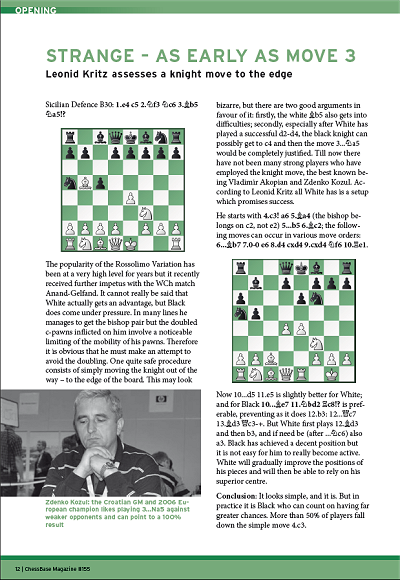
Leonid Kritz: "Strange - as early as move 3"
Sicilian B30 - 1.e4 c5 2.Nf3 Nc6 3.Bb5 Na5)
With the line 3...Na5 the German GM Leonid Kritz presents you a repertoire idea against the popular Rossolimo Variation. With this strange knight move Black avoids the doubling of his c-pawns. White also has to waste time because his Bb5 is not optimally placed. In the ideal case, Black can later move his Na5 to c4.
How should White react to the bizarre knight move? What are the practical prospects for Black in this line?
Download the opening survey for free (CBV file for ChessBase 12/Fritz 13)...
Load extract from CBM 155 (pdf)...
| | Opening surveys Tibor Karolyi: English A31 1.c4 c5 2.Nf3 Nf6 3.d4 cxd4 4.Nxd4 g6 5.Nc3 d5 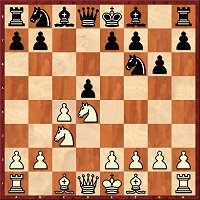
| | This variation is especially interesting for Benoni players, who after 1.d4 Nf6 2.c4 c5 3.Nf3 g6 4.Nc3 cxd4 5.Nxd4 d5 reach the position in the diagram. Positions frequently arise which are known from the Grünfeld Defence. |
Rotstein: Modern Defence A42
1.d4 g6 2.c4 Bg7 3.Nc3 d6 4.e4 e5 5.d5 und 5.dxe5 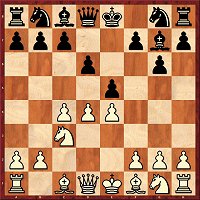
| | Things are not easy for Black in either line, but in each case Arkadij Rotstein shows plans which enable him to keep things level. For White it is above all a question of taste whether to play 5.d5 or 5.dxe5. Objectively speaking he has a slight initiative, but no more than that. |
Kritz: Sicilian B30
1.e4 c5 2.Nf3 Nc6 3.Bb5 Na5 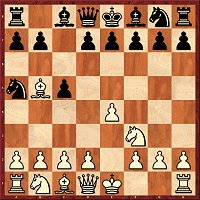
| | With this strange knight move Black avoids the doubling of his c-pawns. White also has to waste time because his Bb5 is not optimally placed. In the ideal case, Black can later move his Na5 to c4. Leonid Kritz shows how, with precise play, White nevertheless obtains an advantage. |
Szabo: Sicilian B76
1.e4 c5 2.Nf3 d6 3.d4 cxd4 4.Nxd4 Nf6 5.Nc3 g6 6.Be3 Bg7 7.f3 Nc6 8.Qd2 0-0 9.g4 Be6 10.Nxe6 fxe6 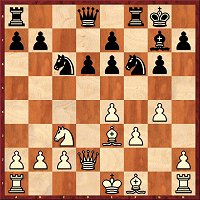
| | As Krisztian Szabo demonstrates in his analyses, Black is also under pressure after 9.g4. Objectively speaking, he can perhaps equalise, but to do so, however, he has to know a lot of precise moves. But even then White has the more pleasant play in the endgame. |
Almasi,I.: French C07
1.e4 e6 2.d4 d5 3.Nd2 c5 4.exd5 Qxd5 5.Ngf3 cxd4 6.Bc4 Qd8 und 6...Qd7 
| | Istvan Almasi compares in this mighty article (there are actually two of them) the two queen moves to d8 or d7 with the actual main move 6...Qd6 and in doing so provides deep insights into the secrets of this variation. |
Postny: Italian Game C54
1.e4 e5 2.Nf3 Nc6 3.Bc4 Bc5 4.c3 Nf6 5.d4 exd4 6.e5 d5 7.Be2 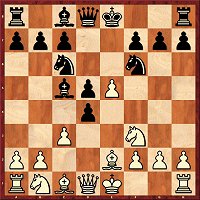
| | Baadur Jobava has experimented successfully with 7.Be2 – instead of going to b5, which frequently leads to the exchange of the bishop, White takes precautions against the expected move ...Bg4. There are some good reasons for the bishop move, but as Evgeny Postny shows, Black can in any case equalise. |
Kuzmin: Queen's Gambit Accepted D22
1.d4 d5 2.c4 dxc4 3.Nf3 a6 4.e3 b5 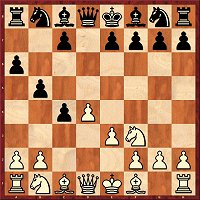
| | Black first of all clings to the extra pawn, in order to exchange off later on as many pawns as possible in the centre. With a symmetrical structure, it often comes down not only to equality but also to a situation in which there is almost always a draw for the taking. |
Marin: Queen's Gambit D37
1.d4 d5 2.c4 e6 3.Nc3 Nf6 4.Nf3 Nbd7 5.Bf4 dxc4 
| | The move 5.Bf4 is becoming ever more fashionable, though it is an ancient one. Mihail Marin has recently had it at the board with both colours. As always, the Romanian grandmaster provides deep insights into the ideas and the individual lines in his subject. |
Stohl: Grünfeld Defence D76
1.d4 Nf6 2.c4 g6 3.g3 Bg7 4.Bg2 d5 5.cxd5 Nxd5 6.Nf3 Nb6 7.Nc3 c6 8.e3 0-0 9.0-0 Re8 
| | Whenever the Fianchetto Variation is played nowadays, there is a high probability that the position in the diagram will appear on the board. Igor Stohl examines the latest trends, including above all the moves 10.h3 and 10.a3. |
Krasenkow: Grünfeld Defence D78
1.d4 Nf6 2.c4 g6 3.g3 c6 4.Bg2 d5 5.Nf3 Bg7 6.cxd5 cxd5 
| | If you want to or have to play this variation, then there is some pre-knowledge you really must have. Thus, after 7.0-0 0-0 8.Nc3 you should not thoughtlessly continue with 8...Nc6 – 9.Ne5 gives White a pleasant game – but the correct move is 8...Ne4. Michal Krasenkow tells you about other subtleties. |
Sumets: Grünfeld Defence D94
1.d4 Nf6 2.c4 g6 3.Nc3 d5 4.Nf3 Bg7 5.e3 0-0 6.Be2 c5 7.dxc5 
| | Can Black be put under pressure with this quiet variation? According to Andrey Sumets there is a lot to be taken into consideration and perhaps the theory of this variation also requires to be re-written. It is well worth knowing what you are doing. |
Schipkov: King's Indian E87
1.d4 Nf6 2.c4 g6 3.Nc3 Bg7 4.e4 d6 5.f3 0-0 6.Be3 e5 7.d5 Nh5 8.Qd2 Qh4+ 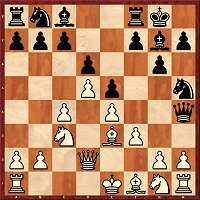
| | The moves 9.g3 Nxg3 10.Qf2 are followed by the queen sacrifice: 10...Nxf1 11.Qxh4 Nxe3. White’s position is not easy to play; he will also lose the c4-pawn and does not have a pawn lever. Boris Schipkov is, however, convinced of White’s advantage and backs up this thesis with relevant analysis. |
|
System requirementsPentium-Processor at 1 Ghz or higher, 512 MB RAM, Windows XP, Windows Vista, Windows 7, Windows 8, DVD drive, mouse, soundcard |














